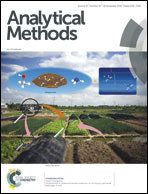An efficient approach for selective electromembrane extraction of benzoic and sorbic acids and saccharin in soft drinks
Abstract
An efficient method for the determination of benzoic acid, sorbic acid and saccharin in soft drinks was developed using the technique of electromembrane extraction coupled with high performance liquid chromatography. Target analytes were extracted into an alkaline solution by applying an electric potential via a liquid membrane supported by hollow fiber. The EME efficiency was tested for several fundamental parameters. The extraction was carried out using 1-octanol as a supported liquid membrane, with an applied potential of 20 V. The pH of the donor phase was maintained at 8.0 and the most suitable solution for the acceptor phase was found to be 0.5 mol L−1 NaOH. The stirring rate was kept at 1200 rpm, and the total extraction time was 30 minutes. The linear range of benzoic and sorbic acids and saccharin was 0.02–2 mg L−1 with correlation coefficients larger than 0.993. The limit of detection ranged from 0.3–0.5 μg L−1, and the limit of quantification ranged from 1.0–1.7 μg L−1. The enrichment factors of benzoic and sorbic acids and saccharin were 179, 122, and 212, respectively. The relative recoveries of the spiked soft drinks were in the range of 89–96%. The results illustrate that it is a simple, promising, and environment-friendly way of detecting and quantifying benzoic and sorbic acids and saccharin in soft drinks.



 Please wait while we load your content...
Please wait while we load your content...